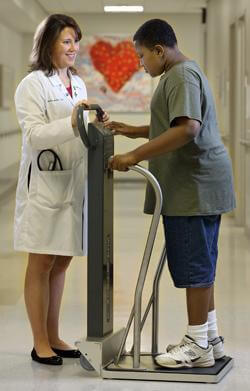 It’s not unusual that 11-year-old Douglas Matthews was undergoing physical therapy at Johns Hopkins Children’s Center—after all, his hip and knee pain was so severe he avoided going outside and walking anywhere. What is unusual is how he found his way to physical rehabilitation—through a multispecialty hypertension obesity clinic at Johns Hopkins where his high blood pressure and weight was being treated, as well.
It’s not unusual that 11-year-old Douglas Matthews was undergoing physical therapy at Johns Hopkins Children’s Center—after all, his hip and knee pain was so severe he avoided going outside and walking anywhere. What is unusual is how he found his way to physical rehabilitation—through a multispecialty hypertension obesity clinic at Johns Hopkins where his high blood pressure and weight was being treated, as well.
“Patients like Douglas, who have multiple medical needs like hypertension and obesity, typically receive care through multiple specialists and health services,” says pediatric nephrologist Tammy Brady. “Because these conditions are related, we created a one-stop shop to treat all of the aspects of hypertension and obesity, as well as make it easier for families who have had to jump from provider to provider.”
In addition to a pediatric nephrologist and pediatric cardiologist, clinic staff include a dietician, physical and occupational therapists, and a behavioral psychologist. They see patients frequently—every three months rather than every six months—to keep them on track with the treatment plan. At each 2 ½ hour visit, the dietician guides the patient on nutrition and weight loss, the physical therapist on exercise options, the occupational therapist on how to incorporate recommendations into daily life, and the behavioral psychologist on underlying mental health issues like anxiety and depression that may be influencing the patient’s eating habits. Treatment recommendations promote a heart-healthy lifestyle—a diet that includes five fruits and vegetables daily, fewer sugar sweetened drinks, limited screen time, and one or more hours of physical activity each day.
“Our dietician does a full metabolic workup and we assess patients for any physical reasons they can’t be active,” Brady says. “We individualize care and go more in depth about a patient’s particular risks.”
Also, an echocardiogram is performed as part of an assessment by the pediatric cardiologist of the patient’s cardiovascular system for early signs of heart disease. All children with high blood pressure are at risk of heart thickening, or left ventricular hypertrophy, Brady notes, especially those who are overweight or obese.
How effective has this combined clinic been for patients like Douglas?
“He’s doing good with keeping his weight and blood pressure down,” says his father, Douglas Matthews Sr. “He’s walking more, too, with no pain.”
For more information, call 410-955-1247
